- Dodge wants muscle car buyers to embrace EVs with nostalgia and speed
- The Dodge Charger Daytona EV is anything but quiet
- The 2024 Dodge Charger Daytona costs $61,590
Its looks are inspired by a 1960s muscle car. Its form factor was last popular in the 1970s. And its name is taken from a bewinged NASCAR special driven by Richard Petty, among other NASCAR legends. But it’s also thoroughly modern, marking its brand’s first full step into the electric era.
It’s the 2024 Dodge Charger Daytona, and it aims to bring muscle car fans into the electric fold with nostalgia and performance.
The Charger arrives by the end of the year with a two-door fastback body, of the sort that was acceptable as a family vehicle in the 1970s when I was a kid but is now almost unheard of. A four-door version will arrive in the first half of next year as a 2025 model, and the gas Charger Sixpack will come later in the year, powered by a twin-turbocharged 3.0-liter V-6. All versions will ride on the STLA Large platform that parent company Stellantis has developed for gas and electric powertrains.
The 2024 Dodge Charger Daytona debuts in R/T and Scat Pack trims, both with dual-motor all-wheel-drive powertrains, a 100.5-kwh (93.9-kwh usable) battery, and power that exceeds their gas-motivated Charger and Challenger predecessors.
No SRT variant is due until 2026, but the Charger Daytona is still a multifaceted performer, much of it enabled by its electric powertrains, for better and for worse. Dodge invited Motor Authority to Phoenix, Arizona, to experience those performance capabilities at the nearby Firebird Raceway’s Radford Racing School.
2024 Dodge Charger Daytona
Charger Daytona: Fake sounds, muscle car rumble
My day started with a street drive into the hills in the base R/T model, and ended with a street drive through suburban traffic in a Scat Pack. The R/T’s dual permanent-magnet motors spin out 456 hp and 404 lb-ft of torque, and the standard Stage 1 tunes that up to 496 hp via a Power Shot feature that is available for 10-second bursts. It can get up to 308 miles of range on a charge, and its 400-volt battery can charge at up to 183 kw on a 350-kw plug, which will let it go from 5-80% in 32.5 minutes.
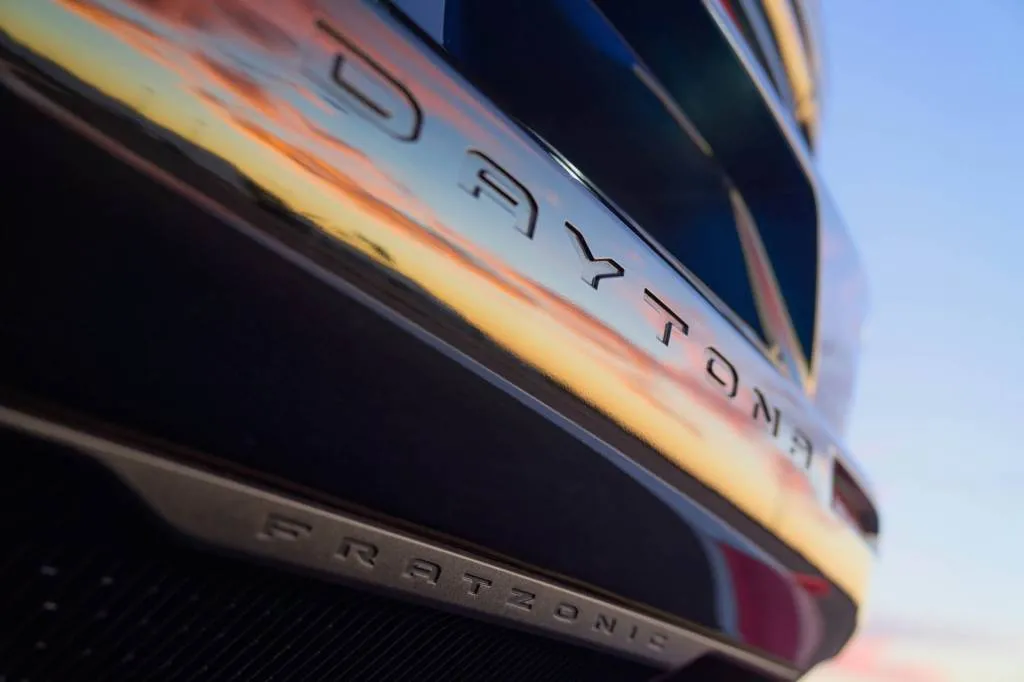
2024 Dodge Charger Daytona
The sound from the R/T’s Fratzonic “chambered exhaust” became apparent as soon as I hit the start button behind the shift lever. Rather than the typical EV spaceship whir, the Fratzonic chamber, which is essentially a subwoofer located below the rear bumper, belted out a V-8-inspired rumble that reacted to the throttle position with a proper muscle car note. It sounded and felt realistic from inside thanks to a little vibration, but from outside it sounded like it was being played through a tape deck.
Fratzonic really made itself heard during Power Shot stints, activated via a button on the flat-top-and-bottom steering wheel. The rumble became lower and louder while the power hit harder. It’s a gimmick, but a cool one for muscle heads. That Power Shot lets the R/T accelerate from 0-60 mph in a tidy 4.7 seconds, and that power was at the ready whenever my right foot requested it.
The willing power was even more noticeable and the Fratzonic sound louder in the Scat Pack model on my return trip. The Scat Pack ups the output to 630 hp and 627 lb-ft, though the standard Stage 2 tune, again available via the Power Shot, increases horsepower to 670. The Fratzonic note can reach 126 decibels, as much as an outgoing Hellcat. It’s a cool sound, but it can get so loud that some drivers will be tempted to turn it off and run in stealth mode.
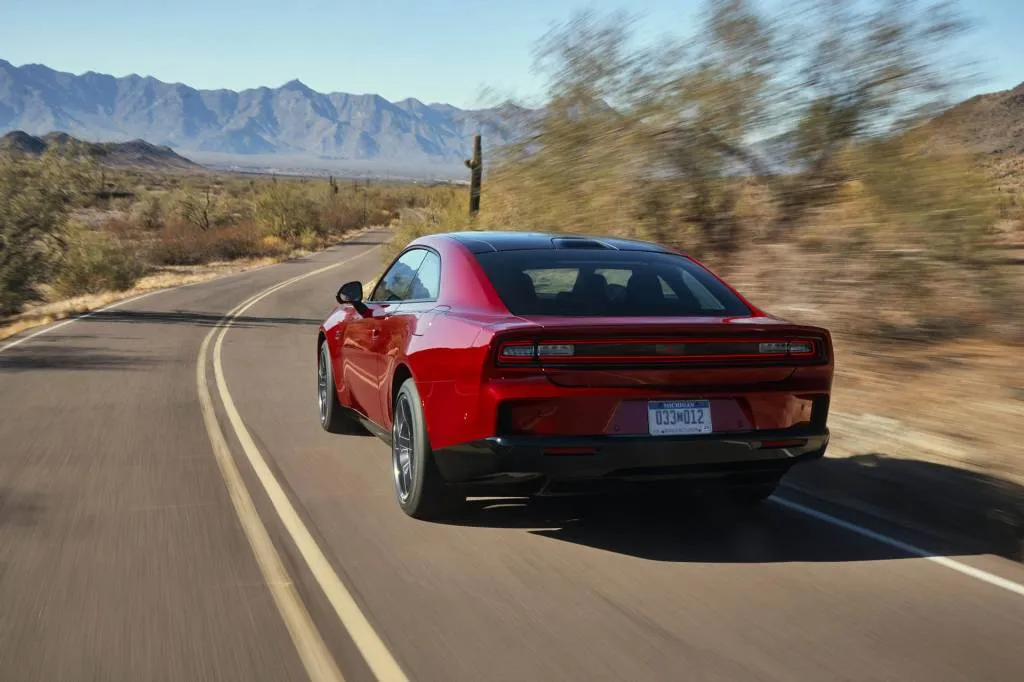
2024 Dodge Charger Daytona
Charger Daytona: Comfortable on the street
The Charger Daytona is a big car at 206.6 inches long on a 121.0-inch wheelbase. That’s 5.8 inches longer than the Dodge Charger it replaces. It’s even 1.6 inches wider than a Charger SRT Wide Body at 79.8 inches. It’s also much heavier, at 5,698 pounds for the R/T and 5,767 pounds for the Scat Pack, versus 4,273 pounds for the comparable 2023 Charger R/T and 4,361 pounds for the old Scat Pack.
On the road, this EV wears its size and weight well. My R/T tester was outfitted with the Blacktop Package that upgrades from the standard 245/55R18 tires to 275/40R20 Goodyear Eagle Sport all-seasons. It rode smoothly on city streets and mountainous twisties. The steering had direct responses but an overly light touch and too little feel through the steering wheel.
When charging into a few corners, the R/T felt a bit top heavy with a little too much lean, but the nose tucked in and the car rotated well. Running in Sport mode, the throttle response was a bit too quick mid-corner as the power began to lift the nose and send the car toward the outside of the turn. Easing off brought the car back in line.
The R/T comes with 13.9-inch front rotors with 2-piston calipers and 13.8-inch rotors with single-piston rear calipers. That’s not overly robust, but they have enough stopping power to get the job done for a couple of short, spirited runs. Better yet, the regenerative and friction braking proved well integrated, which resulted in a natural pedal feel. Dodge offers three levels of regen, which provides roughly 0.1, 0.2, and 0.3 g of deceleration. While Dodge calls it level three one-pedal driving, it’s not, and you’ll need to hit the brake for most turns.

2024 Dodge Charger Daytona
Charger Daytona: Compromised on the track
The day also included laps in the Scat Pack with the Track Package on a small nine-turn, 0.7-mile road course. The $3,495 Track Package upgrades from a square set of 305/35R20 Goodyear Eagle Sport all-seasons to wider 325/35R20 rears. It also gets upgraded brakes, dual-valve adaptive dampers, a stiffer suspension tune, and a larger rear spoiler. The track cars also wore two important options ideal for the track: a set of Goodyear Eagle F1 Supercar 3 summer performance tires and the Drive eXperience Recorder that works like GM’s Performance Data Recorder to record video and telemetry of track laps.
The track time proved perplexing to me. My natural inclination was to run in Track mode, but it quickly became frustrating. As I attacked the corners, the stability control kicked in far too often, settling the body motions and cutting power to prevent me from keeping up with the lead driver.
Then a Dodge rep turned off the stability control completely with a five-second press of the ESC button, a practice I don’t prefer because it can lead to a crash if I go too hard. However, it really revealed the car’s natural handling character. It’s not surprising that the car’s inclination is even more of that lean and push I experienced on the mountain road, with less control of oversteer caused by mid-corner throttle. From there, however, it takes a set and tracks nicely through corners. While I was able to go faster this way, I had to concentrate on smooth inputs to keep the suspension calm.
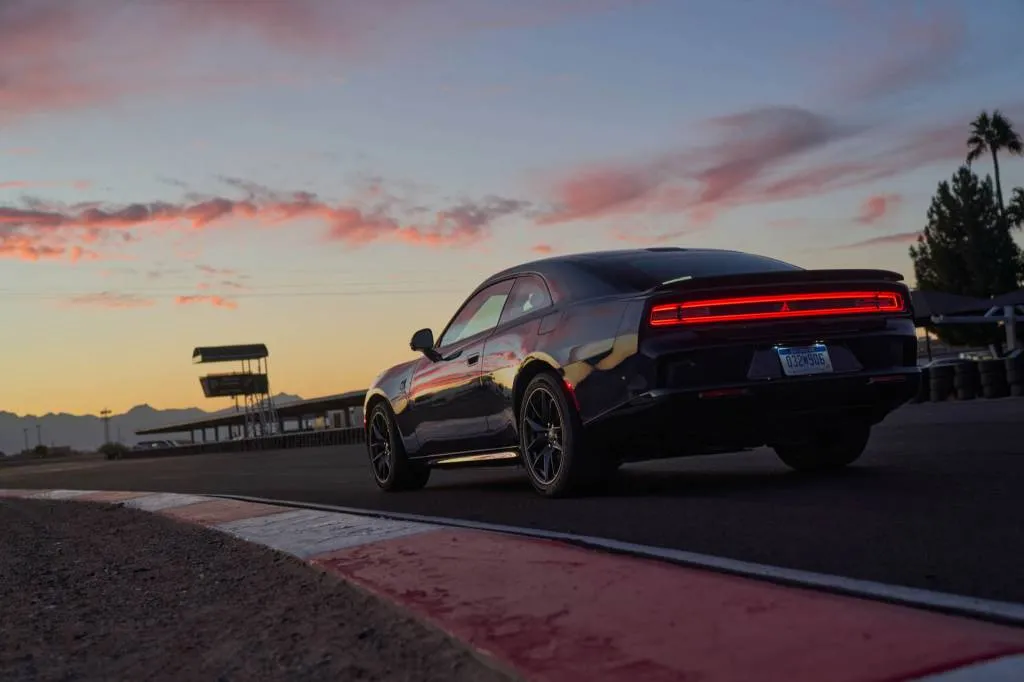
2024 Dodge Charger Daytona
Sport mode proved to be the best way around the track. In this mode, the stability control’s targeted braking kept the understeer in check without cutting the power, which allowed me to rocket out of corners with the help of the standard limited-slip rear differential.
The track allowed the Charger Daytona to break into triple digit speeds and the Scat Pack’s big brakes were up to the task. It has 16.0-inch rotors all around with Brembo 6- and 4-piston calipers front and rear, but the Track Pack upgrades them to two-piece front rotors for better heat management. Hard braking into turn one on the front stretch brought on full ABS braking, but the car slowed as needed and the pedal retained its natural feel with no fade.
Track time didn’t overheat the motors or battery, and Sport mode kept the body motions mostly in check. Still, the weight makes the Charger Daytona a handful, throttle application can upset balance, and the steering needs more feel.
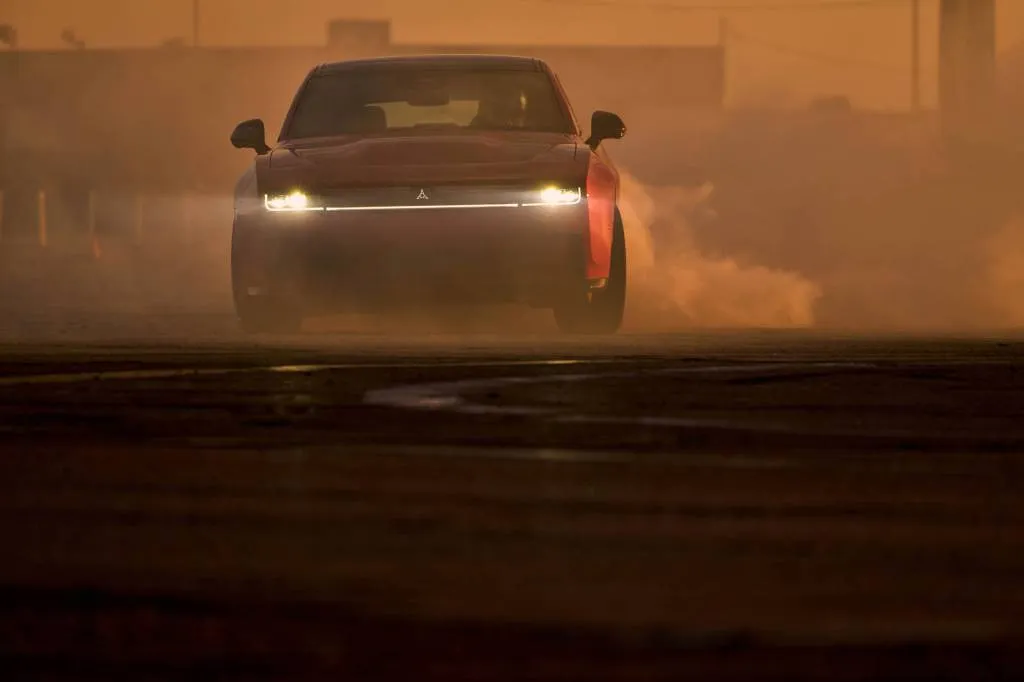
2024 Dodge Charger Daytona
Charger Daytona: Drift machine
The Charger Daytona Scat Pack comes with a Drift mode that disables the front motor. To activate Drift mode, first go to the Vehicle tab along the left side of the touchscreen, then hit Drive Modes and choose Sport. Then back up one screen, choose Race Options, and hit Drift/Donut mode. Next, move a slider on the screen all the way over to Donut rather than Drift Min and Drift Max. Finally, hit the large green Activate Drift/Donut Mode button.
But wait, there’s more. To fully activate the mode you have to put your foot on the brake, shift to drive, make sure the steering wheel is straight, release the brake, and apply a little throttle. It’s now ready for mayhem.

2024 Dodge Charger Daytona
Dodge’s drift exercise involved a simple three-cone slalom followed by a long left-hand turn on a sea of tarmac. The goal was to load up the suspension in each direction, with the emphasis on moving the weight to the right side before the big lefthander. At that point, it was a matter of steering left, mashing the throttle to overcome rear grip, and riding the wave to keep the car drifting.
I gave it four tries. On my first attempt, I got on the throttle too hard and too quickly. The tires easily overcame their traction and I spun out. On my next attempt and last attempt, I didn’t let the suspension load up before getting on the throttle and ended up going too wide. On my third attempt, however, I got it right and rode a glorious drift for about 180 degrees before pointing it back toward the start and letting off.
All the issues were driver error. The Scat Pack has plenty of power and balance to kill tires in magnificent, unnecessary, fun arcs of smoke.

2024 Dodge Charger Daytona
Charger Daytona: Drag chops
I was surprised how much of a non-event it was to drag race the Charger Daytona Scat Pack and put up consistently fast times.
Before taking the Charger Daytona down the strip, it’s best to go to the Performance Pages screens in the infotainment system to check the high-voltage battery level and temperature. A charge of 75% or less will start to degrade power in the Drag mode, and the battery can’t be too hot or too cold, though anywhere from 20-120 degrees should work.
Next, choose the Drag mode either in the screen or with a toggle on the left side of the steering wheel to slow down the steering (you don’t want jerky motions in a high-speed, straight-line blast), and adjust the suspension and regenerative braking. It sends regen to full to help slow down after the run, and adjusts the front dampers to their full firm setting and the rears to full soft to let the car squat for more traction on launch.
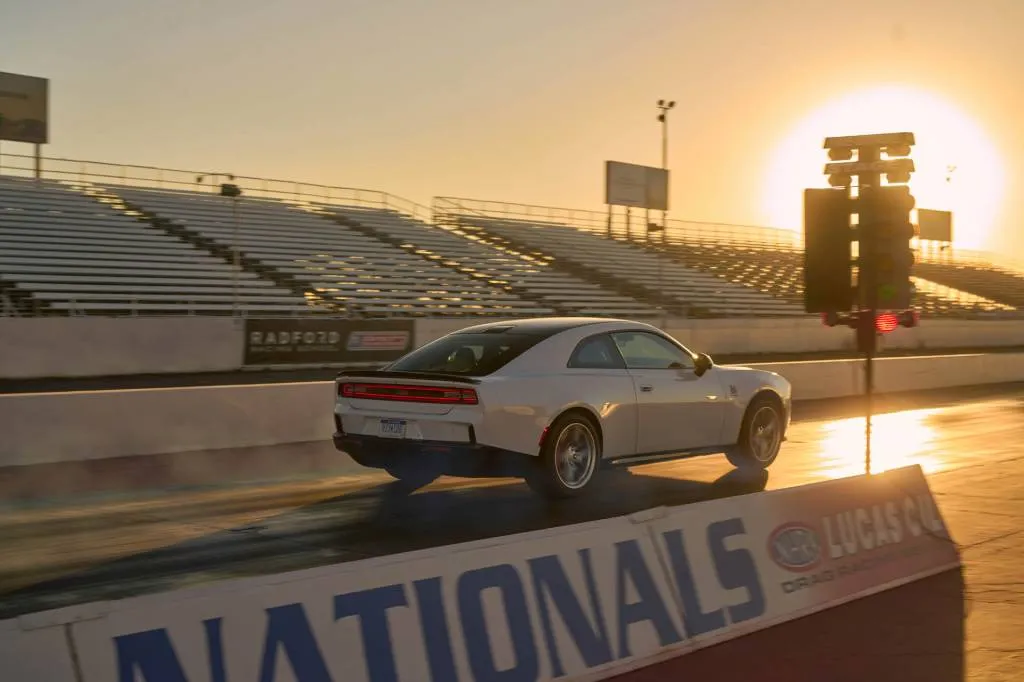
2024 Dodge Charger Daytona
From there, activate launch control in the Performance Pages. It has Max, High, Med (medium), Low, and Min (minimum) settings for how much torque will be unleashed at launch. The Max setting is for a prepped dragstrip with drag radials, and it releases all of the torque immediately. The other settings ramp up the torque after launch, ideally once the tires get full grip. Even though I was on a working dragstrip and the Scat Pack was on its summer tires, I still needed the Low setting to prevent too much tire spin.
The most difficult part of the process was hitting the launch control button while staging the car. Staging involves creeping forward to activate two lights with the front tire, the second about six inches after the first. The goal is to trigger the first light, activate launch control, and creep forward to trigger the second light. Then it’s a matter of quickly braking fully with your left foot and flooring the throttle before the Christmas Tree begins its three-yellow light countdown. Ideally, you’ll sidestep the brake on the second yellow and the car will leave the box on the green.
While I slept at the tree on my first run, the car performed admirably. With all-wheel drive and 670 hp (no need for a Power Shot here as Drag mode unlocks all the power), the rear tires slipped slightly at launch, the power came on hard and efficiently, and the car built speed relentlessly and tracked straight down the strip. I tripped the lights with a time of 11.87 at 117.23 mph. The run sapped about 2.5% of the battery charge.
I cut a better light on my second run, and the car performed consistently, with a time of 11.906 seconds at 117.15 mph.
A few other journalists put up times in the 11.70s, likely due to slightly better traction at launch. Dodge quotes a quarter-mile time of 11.5 seconds, which seems quite feasible with better conditions enabled by more rubber at the line. Given that time, I also buy Dodge’s quoted 3.3-second 0-60 mph time for the Scat Pack.

2024 Dodge Charger Daytona
Charger Daytona: Interior and equipment
Dodge treats the Charger Daytona to a typical dark interior, though it can be brightened up with Demonic Red upholstery in suede and synthetic or real leather. Available ambient lighting highlights extra design flourishes, including crosshatched plastic on the door panels and a tiered dash with big screens aimed at the driver. A pistol grip shifter wrapped in black leather is a throwback to the 1960s Charger, though it would look more convincing if it incorporated some metal.
The cockpit is modern, too, with a 12.3-inch infotainment touchscreen and a standard 10.3-inch digital instrument cluster that can grow to 16.0 inches. The touchscreen uses the simple and quick-acting Uconnect 5 infotainment software, and incorporates both Performance Pages and new EV Pages information to monitor sprint times, power output, auxiliary gauges, battery charge, efficiency info, and much more.
Front seat occupants sit on low-back or high-back bucket seats. I only experienced the high-back buckets and they proved supportive and comfortable with wide seat bottoms and generous bolstering.
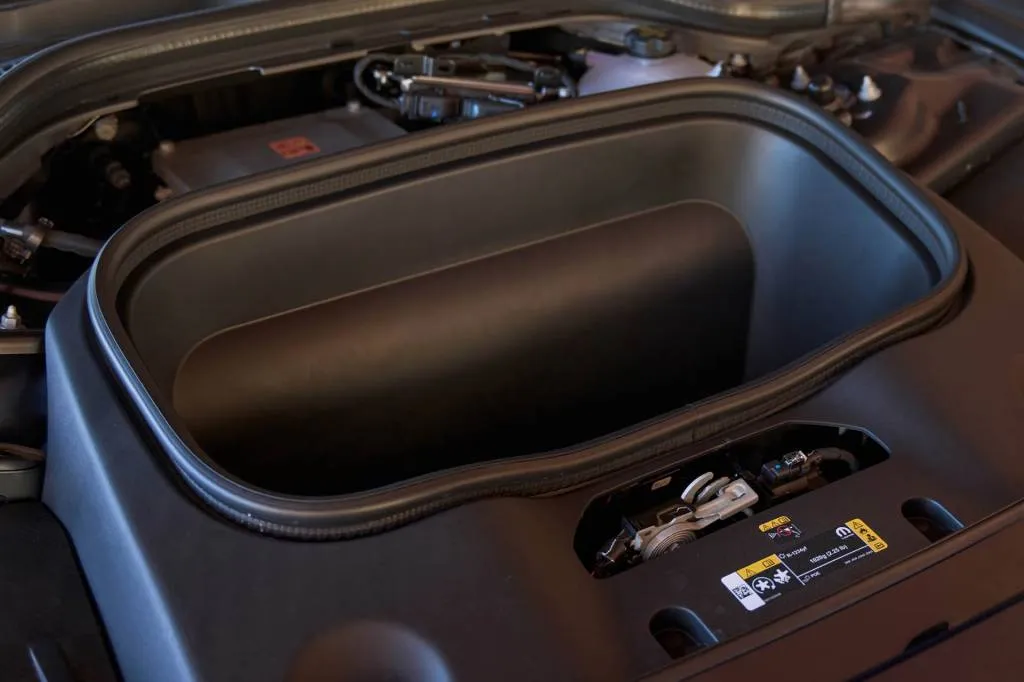
2024 Dodge Charger Daytona
The three-door body style isn’t much of a detriment to passenger comfort. The only issue is snaking your way back to the second row, like I did in my family’s 1969 GTO when I was a kid. Once seated, it has a roomy 37.2 inches of legroom, and just enough headroom for a 6-footer, but no more. The hatchback body style makes cargo room more useful than a trunk. It has 22.8 cubic feet of space with the rear seats up and 37.4 cubes with those seats folded down. Oddly, buyers have to pay extra to get a tiny 1.5 cubic-foot frunk.
The Charger Daytona R/T starts at $61,590, including a $1,995 destination charge. The $75,190 Scat Pack teams its extra power with larger Brembo brakes, launch control, additional performance drive modes, a sportier suspension, and 20-inch alloy wheels. Unfortunately Dodge wraps several tempting options in a $4,995 Plus Group for both models.
Neither Charger Daytona is cheap, but both models improve upon the power and efficiency of their predecessors while delivering the look and sound (even if it’s synthetic) of a beloved 1960s muscle car. The Charger Daytona may be big and heavy, which hurts handling, but muscle cars have always looked good and gone fast in a straight line without the ability to turn corners all that well.
Dodge paid for travel, lodging, and track time for Motor Authority to bring you this firsthand report.








